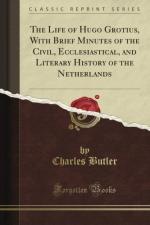In antient geography, the Netherlands were separated into the Cisrhenahan and Transrhenahan divisions: the Cisrhenahan lay on the western side of the Rhine, and included the Belgic Gaul; it was bounded by the Rhenus, the Rhodanus, the Sequana, the Matrona, and the Oceanus Britannicus: the Transrhenahan lay on the eastern side of the Rhine; it was a part of Lower Germany, and bounded on the north by the eastern Frisia, Westphalia, the Ager-Colonensis, the Juliacensis-Ducatus, and the Treveri. The classical reader will have no difficulty in assigning to these denominations, their actual names in the language of modern geography.
The whole of these territories is called the Netherlands by the English; and Flanders by the Italians, Spaniards, and French.
V. 2.
The formation of the different Provinces of the Netherlands into one State.
In 1363, John the Good, the king of France, gave to Philip the Bold, his third son, the dutchy of Burgundy: it then comprised the county of Burgundy, Dauphine, and a portion of Switzerland. The monarch at the same time created his son duke of Burgundy. Thus Philip, became the patriarch of the second line of that illustrious house.
History does not produce an instance of a family, which has so greatly aggrandized itself by marriage, as the house of Austria. The largest part by far of the Netherlands was derived to it, 1st, from Margaret of Franche Comte; 2dly, from Margaret of Flanders; 3dly, from Jane of Brabant; 4thly, from Mary of Burgundy; 5thly, from Jacqueline of Holland; and 6thly, from Elizabeth of Luxemburgh.
[Sidenote: Formation of the Provinces of the Netherlands into one State.]
The possessions of the three first of these splendid heiresses, descended to Margaret of Flanders. She married Phillip the Bold, who, as we have just mentioned, was the first of the modern Dukes of Burgundy. By this marriage, he acquired, in right of his wife, the provinces of Flanders, Artois, Mechlin, and Rhetel; and transmitted them and his own dukedom of Burgundy to his son Charles the Intrepid. From Charles, they descended to his son Philip the Good. He purchased Namur; and by a transaction with Jacqueline of Holland, acquired that province, Zealand, Hainault, and Friesland. By other means, he obtained Brabant, Antwerp, Luxemburgh, Limburgh, Gueldres, and Zutphen. On the failure of issue male of Philip the Good, all these fourteen provinces descended to Mary his only daughter. She married the Emperor Maximilian. He had two sons by her, the Emperor Charles V. and Ferdinand. The former acquired, by purchase or force, Utrecht, Overyssell and Groeningen.
These territories formed what are generally called the SEVENTEEN PROVINCES OF THE NETHERLANDS.
In the language of the middle ages, they consisted of the Dutchies of Brabant, Limburgh, Luxemburgh, and Gueldres; the Earldoms of Flanders, Artois, Hainault, Holland, Zealand, Namur, Zutphen, Antwerp, (sometimes called the Marquisate of the Holy Empire) and the Lordships of Friesland, Mechlin, Utrecht, Overyssell, and Groeningen. Cambrai, the Cambresis, and the County of Burgundy, though a separate territory, were considered to be appendages, but not part of them.




